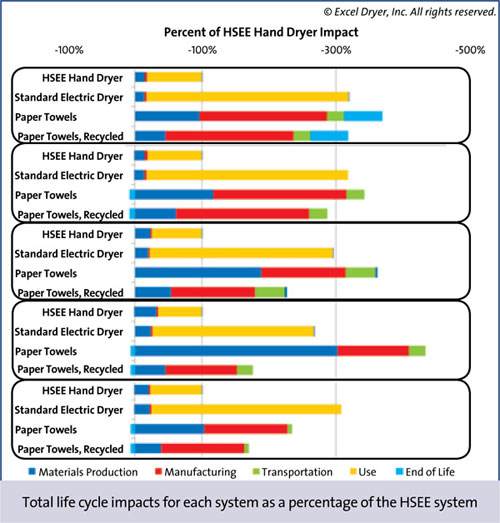Throw in the Towel: High-Speed, Energy-Efficient Hand Dryers Win Hands Down
The Results of the LCA
Overall Conclusions
The overarching conclusion of this environmental Life Cycle
Assessment is that the high-speed, energy-efficient (HSEE) hand
dryer studied "shows a significant advantage in its environmental
impacts in comparison" with a conventional (old technology)
electric hand dryer and the paper towel dispenser tested. Further,
HSEE hand dryers reduce the environmental impact of hand drying
from 50% to 75% vs. either other method. The study also found
that "the comparison among conventional electric hand dryers and
paper towels systems is within a close enough range to be highly
influenced by the specific product and use characteristics and the
assumptions of the study."
Both electric dryers created the majority of their environmental impacts during the use phase, when electricity was being used to dry hands. The paper towel system created most of its negative impacts in the production of the raw materials and the manufacture of the towels, the transportation of the towels to the facility, and the landfill implications of the used towels. All told, the towels themselves are responsible for >90% of the life cycle impacts of that system.
The sensitivity and uncertainty tests showed that the assumptions of the study had very little to do with the outcome, meaning that the results of the comparison were so strong that even when changing a wide range of assumptions one way or the other, it did not substantially change the direction or magnitude of the comparison. Even when recycled paper was used in the towel system, it did not gain substantial ground on the HSEE dryer alternative. Interestingly, the sensitivity tests on "producing recycled pulp suggests that there may be very little, if any, benefit from using recycled content in paper towels."

Results by Impact Category
The chart nearby attributes the total life cycle impacts to each of the five-endpoint or damage categories. It also identifies in graphic form the relative contribution of the five principle life cycle stages - Materials Production, Manufacturing, Transportation, Use, and End of Life. This chart uses the HSEE dryer impacts as the baseline for each category and gives it a value of 100. It then compares the conventional dryer and the paper towel systems - using 0% and 100% recycled sensitivity tests. It shows that the Materials Production and Use phases are dominant for the electric hand dryers, with the Use phase being much more dominant for the relatively less efficient conventional dryer. The Materials Production, Manufacturing, and Transportation phases are dominant for the towel systems. And the towels are the largest impact contributor (between 89 and 94% of the total impacts) across all five life cycle stages in each of the five damage categories (A detailed, numeric accounting is found in the Appendix of the full LCA report.)
LCA Proves the "Sustainability Bottom Line"
For K-12 schools, other educational facilities, and virtually any public restroom setting, the results of this environmental Life Cycle Assessment point to a clear advantage for the HSEE hand dryer system over a conventional hand dryer or a paper towel dispenser system.
Further, that advantage is significant enough that there are few, if any options for paper-based systems to improve adequately to compete with this new generation of HSEE hand dryers on environmental performance. Conventional dryer have been used in the United States for the over 30 years and the new technology is a sufficient enhancement that they will be disappearing as design professionals and owners understand or experience the benefits of the HSEE dryers. While previous LCA research led to inconclusive or contradictory results regarding the relative advantages of paper-based or conventional electric drying methods, HSEE hand dryers have established a definitive advantage in environmental performance over their electronic predecessors and the increasingly obsolete paper towel approach.
When this exhaustive and conclusive environmental Life Cycle Assessment is combined with the other benefits of HSEE hand dryers including: significant return on investment and short payback period, ease of maintenance and repairs, improved hygiene, useful life, reduced opportunities for vandalism, and ongoing operating cost reductions - design professions have a compelling case to make to the owners of virtually any commercial facility including educational, retail, office, restaurant, arena or stadium, convention center and many more.
|









